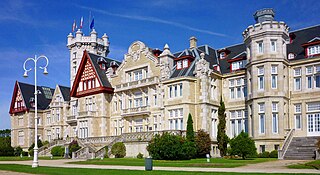
Cantabria is an autonomous community and province in northern Spain with Santander as its capital city. It is called a comunidad histórica, a historic community, in its current Statute of Autonomy. It is bordered on the east by the Basque autonomous community, on the south by Castile and León, on the west by the Principality of Asturias, and on the north by the Cantabrian Sea.

Santander is the capital of the autonomous community of Cantabria, Spain. It has a population of 172,000 (2017). It is a port city located in the northern coast of the Iberian Peninsula, facing the Cantabrian Sea.

Laredo is a town in the autonomous community of Cantabria, Spain. According to the 2008 census (INE), the municipality has a population of 12,648 inhabitants. In addition to Laredo, the municipality includes the villages of La Arenosa, El Callejo, Las Cárcobas, Las Casillas, La Pesquera, Tarrueza and Villante. Except from the last two, the other villages had been physically integrated into Laredo.
The Regionalist Party of Cantabria is the second oldest political party in the Spanish Autonomous Community of Cantabria. The PRC originated in the Association in Defense of the Interests of Cantabria (ADIC), founded on 14 May 1976, with the objective of promoting Cantabrian autonomy.
The Asturias autonomous football team is the regional football team for Asturias. They are not affiliated with FIFA or UEFA, because it is represented internationally by the Spain national football team. The team only plays friendlies.

The Cantabria autonomous football team is the regional football team for Cantabria, Spain. They are not affiliated with FIFA or UEFA and therefore are only allowed to play friendly matches.

The Asón-Agüera comarca is a historical region of Cantabria, Spain. It is located in the upper courses of the Asón and Agüera rivers, near the border with Vizcaya in the Basque Country. The comarca encompasses the basin of the Asón river and its tributaries such as the Gándara.

Ampuero is a municipality located in the autonomous community of Cantabria, Spain. It is surrounded by the municipalities of Limpias, Liendo, Voto, Guriezo and Rasines. Its strategic location in the centre of the Asón-Agüera County has made it the County head town, which contributes to important services and an industrial area in its surroundings. This town has various outdoor activities such as trout and salmon fishing, that provides an exquisite gastronomy. The Virgen Niña festivities, declared of regional touristic interest, have the popular encierros. Ampuero has a 32.3 squared km area, and it is located 55 km away from Santander. According to the 2007 census, the city has a population of 3.682 inhabitants.

Rayo Cantabria, formerly known as Real Racing Club de Santander "B" is the reserve team of Racing de Santander, a Spanish football team based in Santander, in the autonomous community of Cantabria.

The National Museum and Research Center of Altamira, also known as Altamira Museum, is a center dedicated to the conservation of, research into and the sharing of information about the cave of Altamira in Santillana del Mar, named a World Heritage Site by Unesco.

Cave del Valle, locally also known as La Viejarrona, is located near El Cerro Village in the municipality of Rasines in Cantabria, northern Spain. The cave is the source of the Silencio River, a tributary of the Rio Ruahermosa, which in turn is a tributary of the Asón River. Notable for its prehistoric, but particularly for its speleologic significance as it is recognized as one of the longest cavities in the world. The site is very popular among cavers, who have explored a total of over 60 km (37.28 mi) so far.
"Himno a la Montaña", or "Himno de Cantabria", is the official anthem of the Spanish autonomous community of Cantabria. It was composed in 1926 by Juan Guerrero Urresti at the behest of the then Provincial Council of Santander and subsequent arrangements by José del Río Sainz, in the region's official anthem.

The 2011 Cantabrian regional election was held on Sunday, 22 May 2011, to elect the 8th Parliament of the autonomous community of Cantabria. All 39 seats in the Parliament were up for election. The election was held simultaneously with regional elections in 12 other autonomous communities and local elections all throughout Spain.

The 2015 Cantabrian regional election was held on Sunday, 24 May 2015, to elect the 9th Parliament of the autonomous community of Cantabria. All 35 seats in the Parliament were up for election. The election was held simultaneously with regional elections in 12 other autonomous communities and local elections all throughout Spain.

The 1983 Cantabrian regional election was held on Sunday, 8 May 1983, to elect the 1st Regional Assembly of the autonomous community of Cantabria. All 35 seats in the Regional Assembly were up for election. The election was held simultaneously with regional elections in twelve other autonomous communities and local elections all throughout Spain.

The 2019 Cantabrian regional election was held on Sunday, 26 May 2019, to elect the 10th Parliament of the autonomous community of Cantabria. All 35 seats in the Parliament were up for election. The election was held simultaneously with regional elections in eleven other autonomous communities and local elections all throughout Spain, as well as the 2019 European Parliament election.

The 2023 Cantabrian regional election was held on Sunday, 28 May 2023, to elect the 11th Parliament of the autonomous community of Cantabria. All 35 seats in the Parliament were up for election. The election was held simultaneously with regional elections in eleven other autonomous communities and local elections all throughout Spain.

The Monchina, Basque: Behi montxina, is a Spanish breed of mountain cattle indigenous to the autonomous communities of Cantabria and the Basque Country in northern Spain. It is related to the Betizu and possibly to the Terreña breeds of cattle of the Basque Country, and is closely associated with the Villano de las Encartaciones breed of dog, which is traditionally used in managing it. It is classified by the Ministerio de Agricultura, Pesca y Alimentación, the Spanish ministry of agriculture, as a "Raza Autóctona en Peligro de Extinción" or native breed at risk of extinction.

















